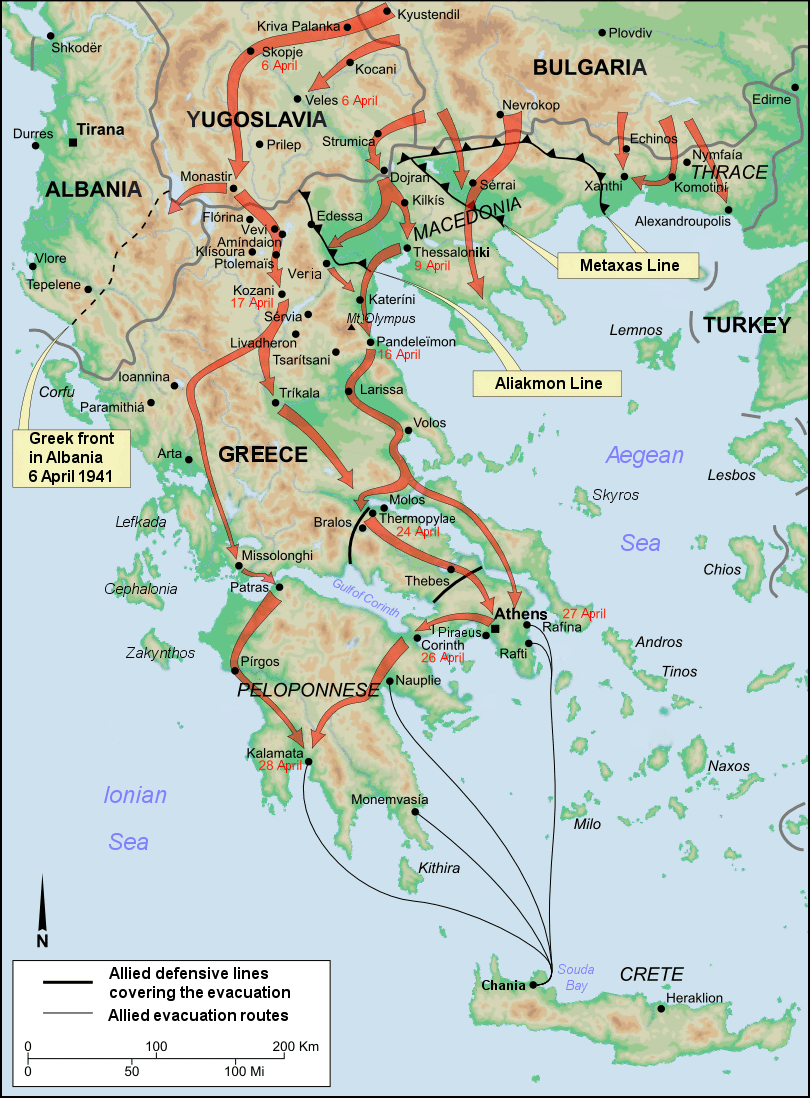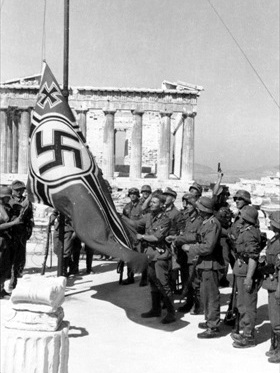HITLER’S OPERATION MARITA DIRECTIVE TARGETS GREECE
Berlin, Germany • December 13, 1940
Italy had long had an interest in the neighboring Balkans, which lay to the country’s east across the Adriatic Sea. In June 1917 Italian soldiers briefly seized portions of central and southern Albania, declaring them a protectorate. Italian Fascism, which was rooted in Italian nationalism, urged Italians to reestablish ancient Rome’s imperium over parts of the Mediterranean basin (Mare Nostrum, Latin for “Our Sea”). Italian dictator Benito Mussolini (1883–1945) made the urge a central part of his foreign policy starting in 1936, gobbling up Ethiopia, Eritrea, and Italian Somaliland, the latter two East African possessions already in treaty relationship with Italy since the 1880s. Between April 7 and 12, 1939, Mussolini overran Albania and made the kingdom a part of his Italian Empire as yet another protectorate in personal union with Italian king Victor Immanuel III.
In mid-1940 a diplomatic brouhaha erupted between Italy and its with Axis treaty partner (since October 1936) to the north, Germany. Without so much as a heads-up to Mussolini, Adolf Hitler sent German troops to Romania ostensibly to guard that country’s oil fields, so vital to the German war machine, and to train members of Romania’s armed forces. However, Italians in general and Il Duce (Italian, “the leader”) in particular believed Romania was in Italy’s sphere of interest; thus, Mussolini sent his expeditionary force of 55,000 men over the Albanian frontier into neutral Greece on October 28, 1940, and let Hitler learn all about it in the media. (Hitler was livid.) Within three weeks the Greek army launched a fierce counteroffensive and found itself a good way into Italian Albania. Mussolini’s invasion force, ill-prepared, poorly led, and insufficiently equipped compared with better-disciplined, better-motivated, and better-equipped Greek forces, was now on the back foot.
The Greco-Italian martial maneuvers, against the backdrop of Great Britain’s Declaration of April 13, 1939, to assist Greece should that country’s independence be threatened, jeopardized Hitler’s preparations to liquidate his archenemy, the Soviet Union, in early 1941 (Operation Barbarossa). Royal Air Force squadrons began arriving in Greece in November 1940. Hitler drafted Directive No. 20 early the next month. In it he wrote: “The outcome of the battles in Albania is still uncertain. In the light of the threatening situation in Albania it is doubly important to frustrate English efforts to establish . . . an air base [in Greece] which would threaten Italy in the first place and, incidentally, the Rumanian [sic] oilfields.” In the next two paragraphs Hitler stated his intentions: “(a) To establish in the coming months a constantly increasing force in Southern Rumania. (b) On the arrival of favourable weather—probably in March [1941]—to move this force across Bulgaria to occupy the north coast of the Aegean and, should this be necessary, the entire mainland of Greece.” On this date, December 13, 1940, the Oberkommando der Wehrmacht (German Forces High Command) issued Directive No. 20 outlining the Greek campaign under the code designation Operation Marita.
The subsequent coordinated German and Axis assaults on Greece and neighboring Yugoslavia to the north in early April 1941, or Hitler’s rescue of Mussolini’s “madness,” as he called Il Duce’s Albanian misstep, had the unintended consequence of German military intervention in Mussolini’s Mare Nostrum (Mediterranean realm). Intervention turned into a bigger disaster for Italy than the Italian dictator could ever have imagined—one that culminated in the Italy’s destruction by sparring German and Western Allied armies on the Italian mainland between 1943 and 1945 and his own execution on April 28, 1945, and the public hanging of his corpse the next day in the Piazzale Loreto in Milan, the birthplace of Italian Fascism.
Operation Marita (The Battle of Greece), April 6–30, 1941
 |
Above: Map shows Bulgaria, Hitler’s Axis partner since March 1, 1941, serving as the jumping off point for the German Wehrmacht’s invasion of Greece and Yugoslavia in April 1941. (Hitler used Germany’s 70 percent stranglehold on Bulgaria’s trade to force Bulgarian King Boris III to join the German-led Tripartite Pact.) The success of Operation Marita had the upside of preserving Mussolini’s regime (increasingly unpopular due to Italian military setbacks in Greece, Northeast Africa, Ethiopia, and Somaliland), as well as displacing over 62,000 British and Commonwealth armed service members (as of April 24, 1941) from the northeastern Mediterranean basin.
 |  |
Left: German soldiers raise the blood-red German war ensign (Kriegsflagge) over the Acropolis of Athens, April 1941. Greek resistance fighters prevented the Axis (Germany, Italy, and Bulgaria) from enjoying a peaceful occupation of the mainland. By 1944, 1 in 4 Greeks was a member of the largest Greek armed resistance group, the National Liberation Front (EAM). The German Wehrmacht withdrew from mainland Greece in October 1944 in the face of the Soviet Army’s advance into and conquest of Bulgaria to the north. Isolated German garrisons remained on Crete and some of the other Aegean islands until the end of the war in May 1945.
![]()
Right: American poster supporting Greece, 1942. Greek officers and soldiers who escaped falling into German hands served in Greek units attached to the British Eighth Army, seeing service in North Africa (Operation Torch, November 8–16, 1942) and Italy. The Greek Navy took part in the Allied invasions of Sicily (Operation Husky, July 9/10 to August 17, 1943) and Anzio in Italy and Normandy (Operation Overlord, June 6 to August 25, 1944), France.
Operation Marita, the Axis Invasion of Greece, April 6–30, 1941
![]()

 History buffs, there is good news! The Daily Chronicles of World War II is now available as an ebook for $4.99 on Amazon.com. Containing a year’s worth of dated entries from this website, the ebook brings the story of this tumultuous era to life in a compelling, authoritative, and succinct manner. Featuring inventive navigation aids, the ebook enables readers to instantly move forward or backward by month and date to different dated entries. Simple and elegant! Click
History buffs, there is good news! The Daily Chronicles of World War II is now available as an ebook for $4.99 on Amazon.com. Containing a year’s worth of dated entries from this website, the ebook brings the story of this tumultuous era to life in a compelling, authoritative, and succinct manner. Featuring inventive navigation aids, the ebook enables readers to instantly move forward or backward by month and date to different dated entries. Simple and elegant! Click 











